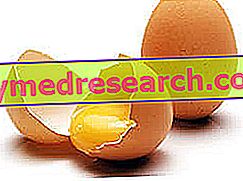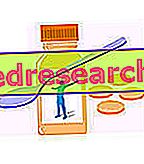Commodity and food legislation
From the chemical and nutritional point of view, the egg is an organic body, in this case a lipoprotein food, wrapped in a calcic shell and produced by a category of animals called oviparous .

From the legislative point of view, if not otherwise specified, in Italy "egg" means hen's egg ( Gallus gallus domesticus ) produced on the farm; other breeds of birds used in the production of eggs are: duck, goose, quail, guinea fowl, turkey, ostrich etc.
- Eggs intended for direct consumption are defined as category A, or rather "fresh eggs";
- those of category B, which can be destined to the food industry or NOT food, are defined as "second quality".
The breeds of chicken exploited for the production of eggs are: Livorno, Ancona, Hamburg, Redcap, Campine, Lakenvelder etc. Each of them has characteristics related to the specific breed, but approximately it is possible to define that a naturally bred oviparous hen produces about 100 eggs a year (against the +200 of those subjected to intensive breeding) and that it eats about 190g of food for each egg product (against 210g of those subjected to intensive farming).
Classification and structure
Depending on the weight, fresh eggs are classified as follows:
- XL - very large - weight> 73g
- L - large - weight from 63 to 73g
- M - medium - weight from 53 to 63g
- S - small - weight <63g
Furthermore, the egg can be differentiated on the basis of the production chain and on the type of breeding:
- 0 -From organic farming: which follows the organic regulation
- 1 - Outdoor farming: the hens can scratch outside but the deposition takes place inside the structures
- 2 - Breeding on the ground: the hens are free to move but in a shed; the eggs are laid on the ground or on the nests
- 3 - Breeding the cage or battery (86% of total production): confined breeding and deposition in special collection machines
On the egg shell it is possible to read an alpha-numeric code identifying:
- Type of farming (0, 1, 2, 3 - as mentioned above)
- State of origin of the egg (for Italy IT)
- ISTAT code of the production municipality
- Initial province of production (for example, Fe for Ferrara)
- Identification of the name and location of the farm where the egg was laid
- Expiration date (for fresh eggs is about 29 days)

The chicken egg generally weighs 60g; of these, the shell affects about 7g, 35g weighs the albumen and 18g the yolk; per capita annual consumption per person is around 13.7kg .
Egg yolk
In an average egg about 17-18g
49.1% basically dry lipid substance and 50.9% water. The yolk represents the most "full-bodied" part of the egg; it is frequently used for stand-alone preparations (such as zabaglione) or as a liqueur base (VoV, Zabov etc.). This statement is easily justifiable by observing the amounts of nutrients it contains; the yolk uses a good portion of protein (15-16g / 100g) but above all of high biological value (the highest in absolute with that of the egg white and milk, with protein index 100). The polypeptides that compose it are mainly phosphorus proteins (LIPO-proteins and lipids coniungate containing phosphorus - P) and pseudoglobulins (phosvitin); phosphorus proteins containing a lot of sulfur are lipovitellin and lipovitellinin.
NB . The fat portion bound to the lipoproteins consists mainly of phosphatidylcholine (the main constituent of lecithin) and represents 8% of the total lipids.
Also the lipid ration is important; it consists in particular of saturated fatty acids (31% of the total) but with an ac ratio. Polyunsaturated fat / saturated 0.5 (which also indicates a good percentage of PUFA fatty acids). The cholesterol content is very high (> 1300mg / 100g) and strongly limits the use of the yolk; some specialists stress the fact that, although the quantity of this molecule is high, there are no studies showing its hypercholesterolemizing potential. In my opinion it is not necessary for a study to prove it, or better, egg yolk must be used on the basis of the chemical and nutritional characteristics that distinguish it, without discrimination but not false conjectures. It matters little if there is also an important amount of lecithin PROBABLY involved in steroid chelation in the intestinal lumen (potential cholesterol-lowering effect), what is certain is that the consumption of 1 yolk represents 78% of the MAXIMUM DAILY cholesterol recommended .
The saline contribution of the yolk is abundant, in particular the phosphorus (P) and iron (Fe) content stand out.
Also the vitamin intake is noteworthy, especially for the fat-soluble: retinol-β-carotene (vit. A), calciferol (vit. D) and tocopherols (vit. E). There are also water-soluble vitamins such as thiamine (vit. B1), riboflavin (B2) and niacin (PP).
Egg whites
In an average egg about 31-32g
14.1% of basically proteinaceous dry matter and 85.9% of water. The albumen is composed of an aqueous colloidal matrix consisting basically of proteins (albumin), few lipids and mineral salts. The polypeptide ration is particularly noteworthy in that, in the sports environment and especially in that of aesthetic culture, the consumption of food supplements based on albumen protein or liquid egg white in brik is particularly widespread.
Egg white protein framework: ovalbumin (60-70%), with albumin (9-13.8%), ovomucoid (13-14%), ovoglobulin (2%), mucin (0.06%), lysozyme (3-4%), avidin (0.05%).
Table of amino acids contained in egg whites:
Egg white (%) | Whole egg protein complex (%) | |
| Lysine | 6:48 | 5:35 |
| Tryptophan | 1:04 | 0.99 |
| Phenylalanine | 5:34 | 4.92 |
| Leucine | 7.89 | 7.87 |
| isoleucine | 5.80 | 5:39 |
| threonine | 4:39 | 4:32 |
| Valine | 6.71 | 6:10 |
| Arginine | 4:38 | 5:43 |
| Histidine | 2:17 | 1.84 |
| Methionine | 3.74 | 2.81 |
| cystine | 2.68 | 2:00 |
| Glycine | 3:38 | 3:45 |
| Aspartic acid | 9.95 | 9:39 |
| Glutamic acid | 11.61 | 10.96 |
| Proline | 4:06 | 3.91 |
| Tyrosine | 2.99 | 2.93 |
The albumen is rich in enzymatic and antibacterial inhibitors among which the most present are the ovomucin protein (enzyme inhibitor) and euglobulin (antibacterial constituent of avidin, biotin inhibitor protein or vit. H).
The saline contribution of the egg white is NOT peculiar and, with the exception of chlorine (Cl), it is lower or similar to that of the yolk. The vitamin amount concerns above all thiamine (vit. B1), riboflavin (B2) and niacin (PP).
Eggshell
In an average egg about 5.5-6g
The shell is the NOT edible portion of the egg; it represents just over 10% of the total weight and consists mainly of: calcium carbonate, magnesium carbonate, calcium phosphate and traces of organic substances.



